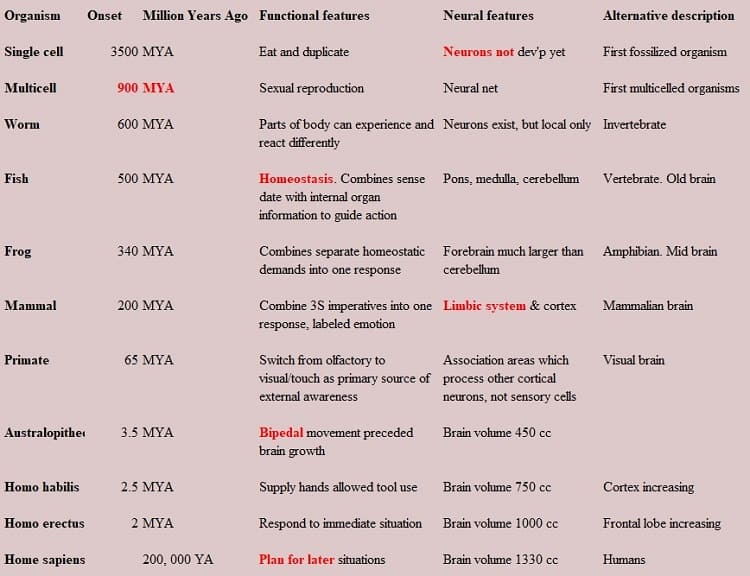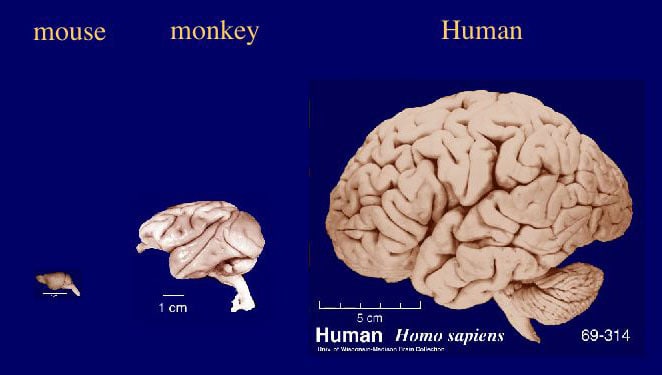The human brain is immense. It is comprised of 100 billion neurons with many thousands of interconnections. It is no wonder that definitive statements about its overall operation are few and laden with qualifiers. Nonetheless, it’s useful to observe that the brain has evolved by increments over the Earth’s history. A species masters an ecological niche. It develops behaviors that allow it to thrive and propagate. When the organism mutates or the environment changes, the current species may alter their behaviors to fit the new situation. From existing actions, modified behaviors form the life style of the newly emerging species.
Nature Abhors Waste
New species, adapting to new environmental niches, build their behaviors upon what was working in the parent species. Physical organs do not arise from nothing. Instead of an eye with no predecessors, descendant species gradually develop improvements of photon sensitivity. The genetic inheritance of a new species almost always consist of incremental genetic changes rather than entirely new genetic solutions.
Incremental Expansion of Niches
Evolution is a response to new environmental challenges as much as it is due to new genetic material. Once a niche is saturated, variants of the organisms (the proportion of genes in the species shifts) start to compete to open new niches. Genetics is a hardened, generic solution that allows a species to flourish in its environmental niche, yet be flexible enough to adapt to new opportunities. In the next page, Brain Through the Ages this Darwinian idea will be developed with respect to the brain.
Biological Brain Stages

The growth of brains commenced with multicelled organisms. At the top of Figure 12.1, single celled organisms react directly to their environment. There is no intermediate layer of processing sensory information. Then after two and a half billion years, multicellular organisms appear on the scene. Their fossils reveal the neural net structures, not centralized brains, but clusters of neurons processing the local sensory information.
Invertebrates, like worms, developed further neural processing of local information over several hundred millions years until fish (vertebrates) came on the scene. Fish display a recognizable brain structure, concentrated in the head with old brain features that reside at the base of human brains. Pons and medulla process distant sensory data and internal organ statuses to use the cerebellum in direct the fish response. An early example of homeostasis.
When mammals came on the scene two hundred million years ago, the 3S Imperatives (Satiety, Sex, and Safety) which typically can not be completely satisfied at the same time, were aggregated. This incomplete satisfaction lies at the source of our emotions.
When the dinosaurs died out and primates exploded in the vacant environmental niches, two important brain developments occurred. First, the primary mode of reacting to the world shifted from smell to vision. Distant objects assumed a great importance. Also, the growing cortex–the increasing volume of neurons in the brain–specialized into association areas. These cortical modules did not process sensory data. They processed and merged information from the various senses into a unified view.
After tens of millions of years, certain primates developed the ability to walk upright. This was followed by a quick explosion of cortical capacity. In a million years, homo habilis was using his hands to manipulate the environment with tools. Homo erectus, two million years ago had a brain capacity two-thirds of current day humans. Two hundred thousand years ago, homo sapiens emerged with a greatly expanded frontal capacity in its cortex. The area known to house our planning and executive functions.
Many of the layers of decision-making are unconscious. The driving impulses of hunger, sexual desire, and fears for safety arose long before the conscious, verbal, reflective capabilities of our neural apparatus came on the scene. There is no conscious attention nor analytical thought needed to guide their behaviors, although we can sometimes control them.
The Adult Human Brain
Following the Brain through the Ages, which expands on the genetic layering introduced above, the Development of the Adult Human Mind will discuss the cultural molding experienced atop the biological changes that accompany growth from infant to maturity.

